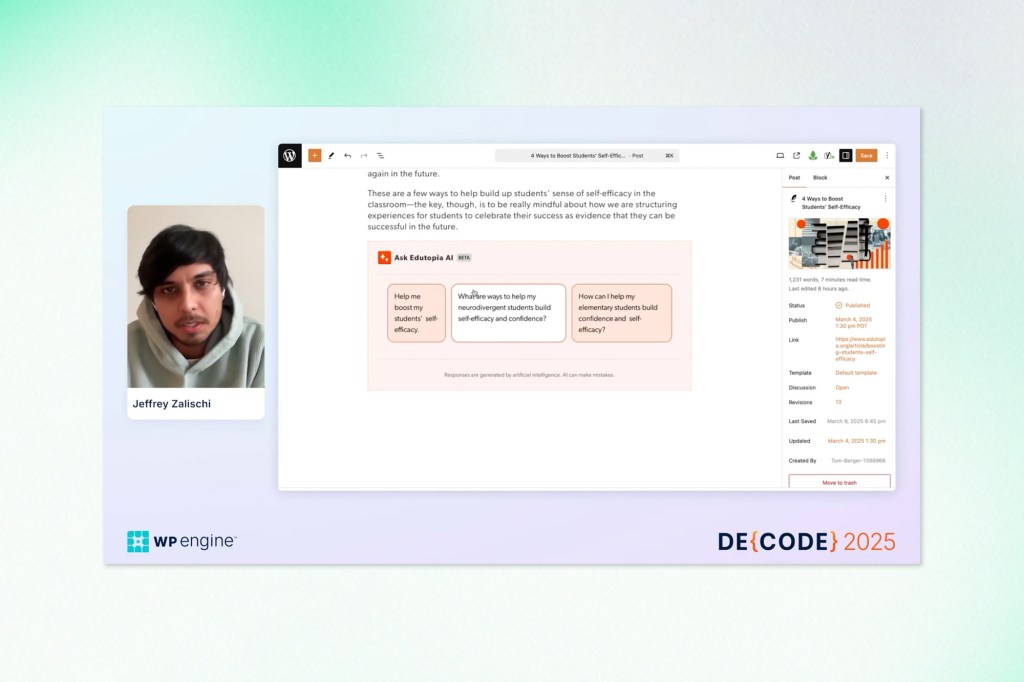AI promises to transform how we search, create, and connect with content, but in practice, many teams are left navigating vague claims and underwhelming tools. At DE{CODE} 2025, WP Engine’s Luke Patterson hosted a refreshingly honest session with Elastic’s Justin Castilla and our team from Trew Knowledge to explore what AI actually looks like in the WordPress ecosystem when it’s working as intended. From vector databases to custom editorial tools, the session revealed what separates empty hype from real-world results.
Cutting Through the Noise
Luke Patterson opened the session with a dose of realism: yes, AI is full of promise, but it’s also flooded with hype. We’ve all heard the stories—someone buys into a flashy tool that never delivers, usually because it’s not grounded in real data, infrastructure, or use cases.
So, how do we identify solutions that work versus those that just sound impressive? Justin Castilla from Elastic broke this down by showing how search and recommendations are being transformed by AI, particularly through vector databases and hybrid search models that combine semantic and lexical approaches.
Demystifying the Vector Store
Castilla helped explain what a vector database is in plain terms: it’s a system that converts words, images, and even videos into numerical representations that capture the deeper meaning and relationships between items. These vectors allow systems to “understand” that a “red hoodie” and a “crimson sweatshirt” are similar, even if the text doesn’t exactly match.
This approach is the foundation of AI-enhanced search and recommendation systems. Once your content is embedded into vectors, it opens the door to smarter retrieval and personalization.
Feeding Vectors with WordPress Content
So, how do you get WordPress content into a vector database? According to Castilla, content from your CMS—a blog with a few hundred posts or a media library with thousands of assets—can be ingested into a vector database using tools like web crawlers, inference pipelines, or native API integrations. Once indexed, this content becomes instantly more discoverable and adaptable for AI-powered experiences.
This setup makes it easy to layer advanced AI experiences on top of your existing WordPress content without having to rebuild everything from scratch.
Building Beyond Search: RAG and AI Summarization
One of the most potent applications Castilla highlighted was the Retrieval-Augmented Generation (RAG). With RAG, an LLM (like GPT or Gemini) can access your internal content, such as blog posts, help docs, or even regulatory PDFS, and generate responses or summaries grounded in your actual data.
Keeping Hallucinations in Check
As generative AI becomes more integrated into editorial workflows, hallucination remains a key concern. Castilla offered three guardrails to reduce risk:
- Use modern, well-trained LLMs.
- Feed them trustworthy, relevant content through RAG pipelines.
- Apply prompt engineering that explicitly instructs models to admit when they don’t know something.
Together, these approaches ensure that AI tools are reliable partners, not creative fiction machines.
Real AI in Action: Trew Knowledge and Edutopia
After exploring the underlying technology, Luke invited Trew Knowledge to share how we’ve brought these concepts to life on a live WordPress site. Our technical lead, Jeffrey Zalischi, and CTO, Anthony Moore, joined the session to walk through an AI-powered editorial and discovery system we built for Edutopia, a platform for educators by the George Lucas Educational Foundation.
Starting Small with Generative AI
Our journey began with a simple goal: to give Edutopia a way to explore how generative AI could support its content strategy. We started with a lightweight chatbot trained on Edutopia’s content—quick to deploy and easy to demo. It helped win stakeholder buy-in and sparked deeper conversations about long-term AI strategy.
From there, we expanded into a WordPress-integrated solution that could support editors and end users—the Ask Edutopia AI feature.
Editorial Support with a Custom Gutenberg Block
We built a custom AI-powered Gutenberg block for the WordPress admin. Editors can input prompts—asking for summaries, generating tables, or retrieving related content—and the block fetches context-aware responses. It also allows the editor to include the current article or tap into additional content sources as part of the prompt.

A Vectorized Knowledge Base Behind the Scenes
What powers these responses? A rich vector database built from Edutopia’s full content library. As new articles are published in WordPress, they’re automatically vectorized and added to a graph database using Neo4j. This structure connects articles, authors, comments, and categories to create a true content knowledge graph.
The result is a system that enables smarter recommendations, personalized experiences, and dynamic editorial tools—all grounded in Edutopia’s existing content.
For example:
- Educators see related articles based on their role (e.g., middle school teacher) or interests.
- Editors get access to internal content relationships when drafting new pieces.
- The AI can surface top-performing posts or generate highlights for specific audience segments.
Scoping AI Features the Right Way
When Luke asked how we scoped this AI-powered solution, our CTO, Anthony Moore, emphasized one thing: start simple. The project began with a lightweight ChatGPT-style tool trained on Edutopia’s existing content. This helped stakeholders see tangible results quickly and helped gather feedback for future iterations.
From there, we moved to a more integrated editorial tool and eventually expanded into content relationships and personalization features.
With AI evolving rapidly, our approach has been to stay focused on solving real problems incrementally, not chasing every trend. It’s a strategy we recommend for any organization: start with a clear problem, build the smallest useful tool, and grow from there.
Want to explore what AI could do for your organization?
AI isn’t just about adding magic dust to your stack—it’s about thoughtful architecture, clean data, and clear use cases. For WordPress users and enterprise publishers, it’s about turning static content into structured intelligence.
At Trew Knowledge, we’re excited about what’s possible when AI meets open platforms like WordPress. But more importantly, we’re committed to building what actually works. Reach out to our experts to learn how we’re helping enterprises integrate AI with WordPress—from search and personalization to editorial support and beyond.


